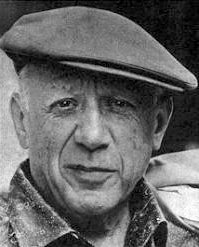INFORMATION - PEOPLE

Pablo Ruiz Picasso (25 Oct 1881- 8 April 1973) was, and continues to be, one of the most iconic, influential and significant artists of the 20th century. He was the most prolific artist in the history of Western art, producing sculptures, drawings, ceramics, photographs, collages as well as over two thousand paintings. Within these various media, Picasso explored many different styles, techniques and ideas, most famously becoming a leading figure in the Cubist movement. However lesser known is the influence African art had upon his groundbreaking work, as it did on many of his contemporaries in the early 20th century European avant-garde.
Picasso was born in Malaga, Spain. After studying art for only a short time in Madrid, Picasso moved to Paris in 1900 splitting his time between there and Barcelona. It was also during this period that he met life-long friend Henri Matisse. Denise Murrel has emphasised Picasso’s role, along with Matisse, as a key figure in ‘the spread of interest in African-influenced modernism among the avant-garde in the United States.’ Working contemporaneously African-American leaders such as W.E.B Du Bois and Alain Locke recognized the importance of art in engendering a positive perception of black culture, and therefore the potential of African-Americans, in a country still firmly in the shadow of institutionalised slavery which had only been finally ended throughout the U.S. in 1865.
Locke saw the popularity, within both the avant-gardes and more general white American audiences, of African forms and so became involved in promoting these forms to black artists in America. This transnational interest in African forms and expressions, which Picasso and many other leading figures in European artistic movements took, at the turn of the century contributed to the direction which black artists took. Playing also a key role in the positive reception which they received in the cultural explosion that came to be known as the . Indeed, Richard J Powell stated, “The Harlem Renaissance, in so many ways, owes its birth to Euro-African modernism in the visual arts.”
Landmark changes in Picasso’s work, and early signs of African influences can be seen simultaneously in his 1907 painting, Les Demoiselles d’Avignon where a departure from classic Western art styles is clear. The painting depicts five prostitutes, their naked bodies disproportionate and stylised with shocking faces on a flat, splintered plane. The two figures on the right have mask-like faces that are reminiscent of African sculpture, which European audiences would have been made aware of through contemporary museum’s ethnographic collections. Les Demoiselles d’Avignon was a groundbreaking piece which marked a turning point in wider modernist art movements as one of Picasso’s first and most important Cubist explorations.
The ‘scramble for Africa’ meant Europeans had had an increasing presence in the continent and were bringing artifacts back to their countries to display as exotica or ‘ethnographic artifacts’. There have been conflicting accounts of how and when Picasso first experienced African artifacts, and despite earlier claims that he was not influenced by African sources, Picasso later said that his visits to the African collections at the Trocadéro in 1907 were pivotal. He encountered: masks and sculptures, that represented the human form in emotive rather than formally ‘accurate’, realist or naturalistic ways; and African society fetish artifacts. Pieces purported to relate to African religions were particularly enlightening to the artist. Picasso claimed by confronting the spiritual the human mind could be freed, saying ‘Spirits, the unconscious, emotion, they’re all the same thing ... Les Demoiselles d’Avignon must have come to me that very day, but not because of the forms, but because it was my first exorcism painting’.
Picasso continued to create art with ‘primitivist’ influences into the mid 20th century in works such as Woman’s Head (1909), Woman in an Armchair (1909-1910) and Negro Dancer (1937). Robert Goldwater argues that the paintings of 1907 all indicate familiarity with at least two African styles; Ivory coast masks and copper-covered guardian figures of the Bakota tribe of the Gabun. He uses the example of Picasso’s 1907 piece Dancer, as indicative of his subtle and complicated relationship to African art. The raised arm and leg positions clearly mirror images of Bakota headdresses and yet infuse an intensity, violence and sense of movement that such objects did not.
This babaric tone in such work of Picasso's reveals that although he was interested in the form of African art, he was unable...Read More
Contributed by: HGF
 |
Continue the debate on 'Primitivist Picasso' here |
Return to People home